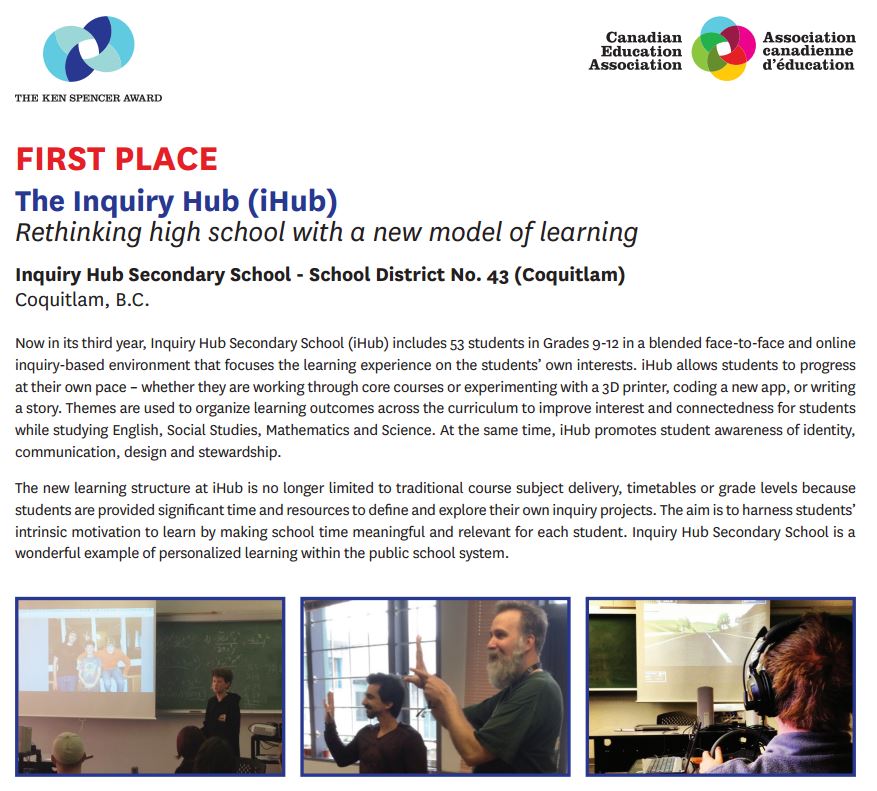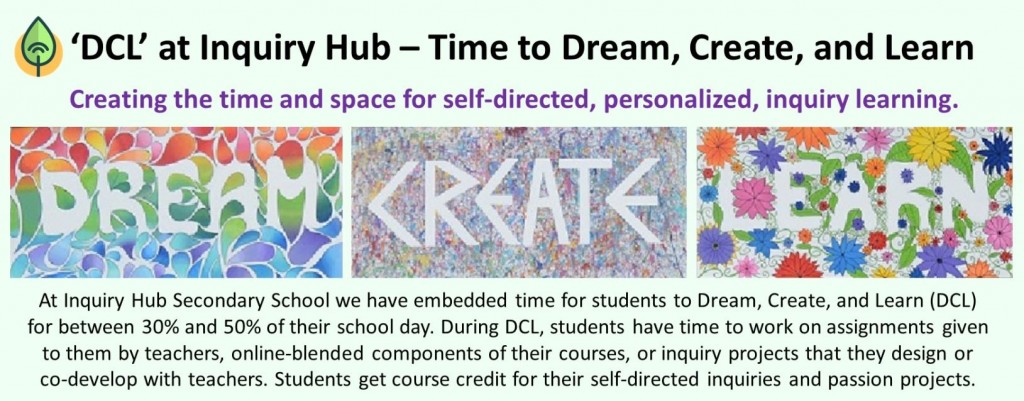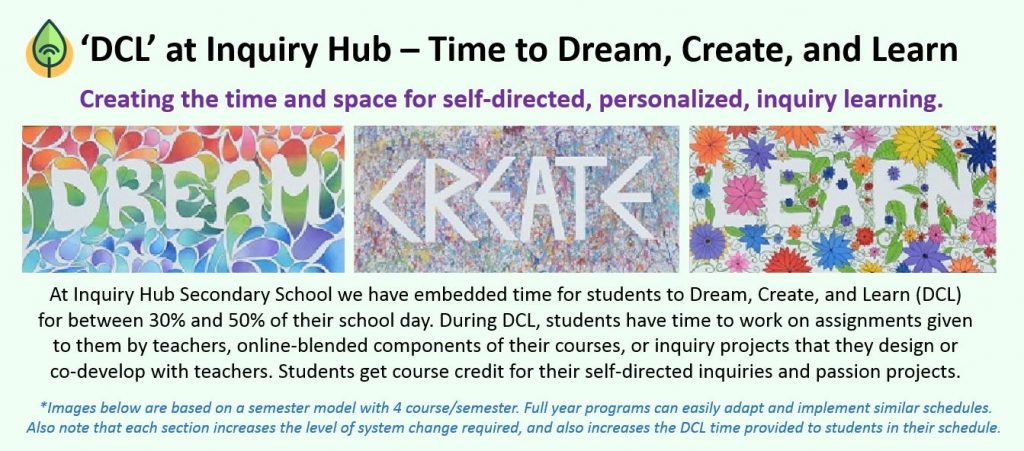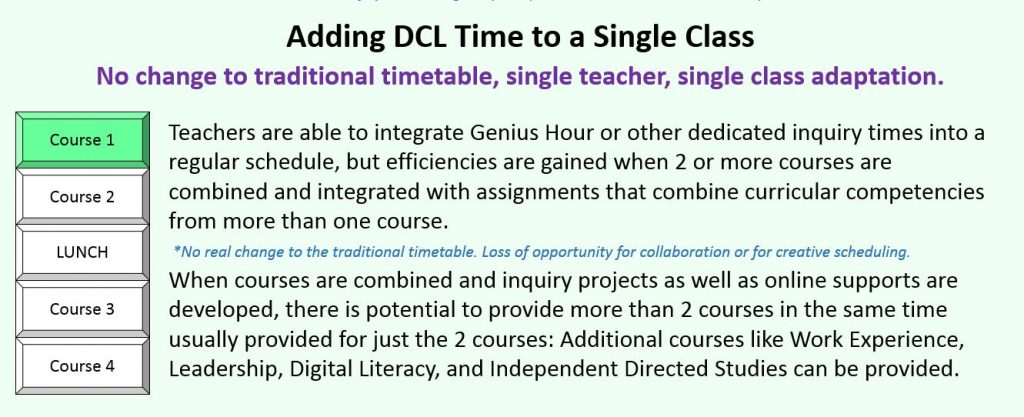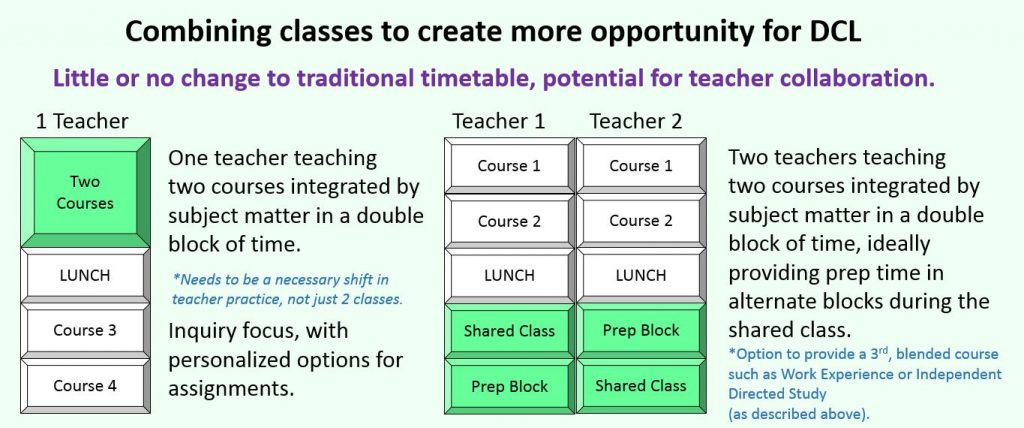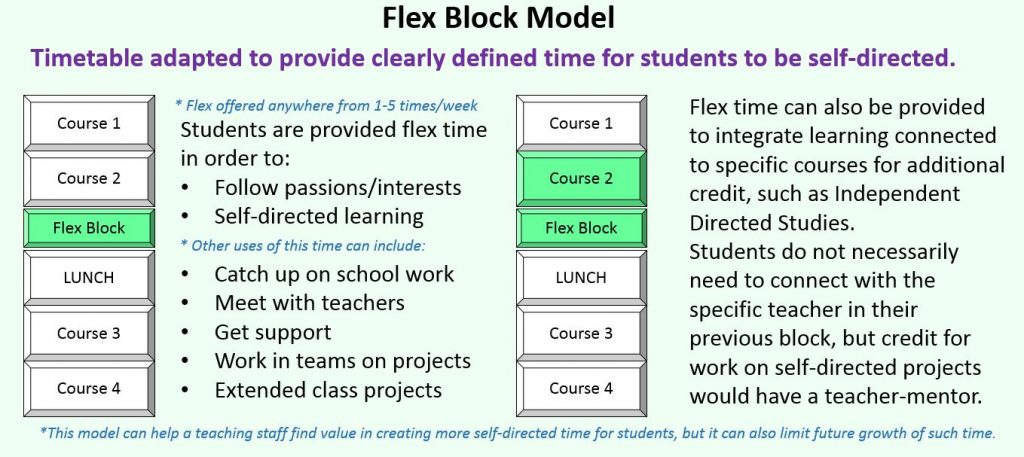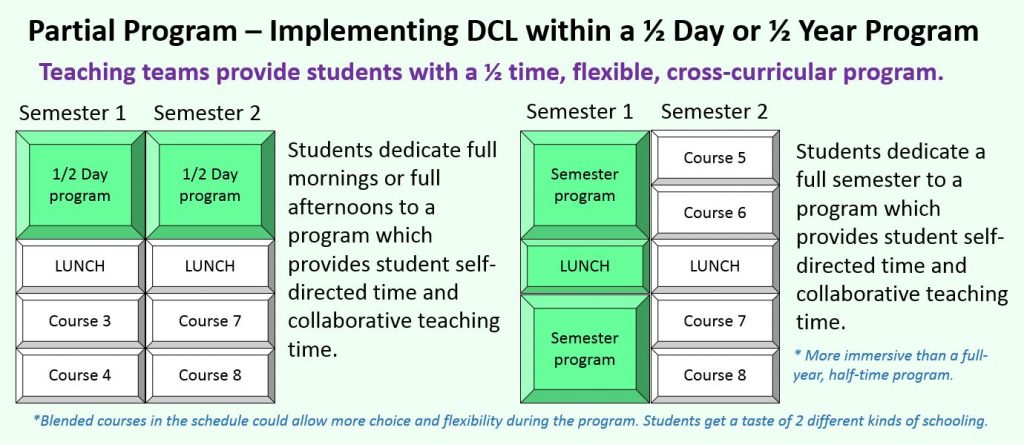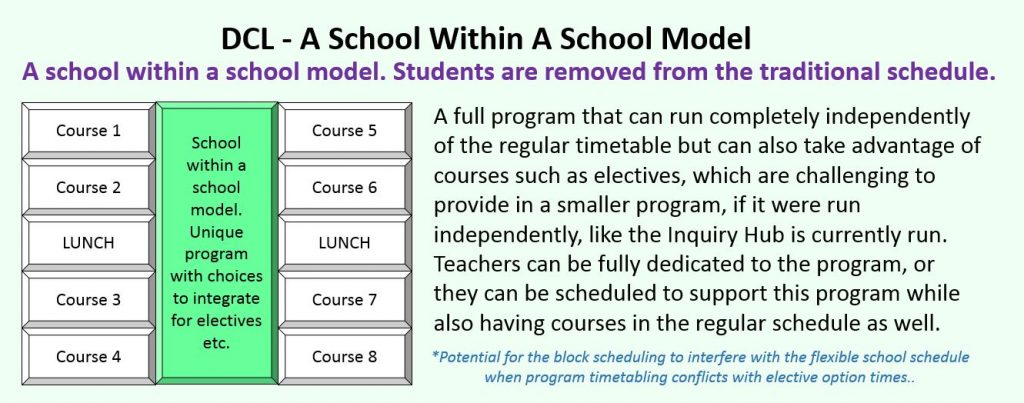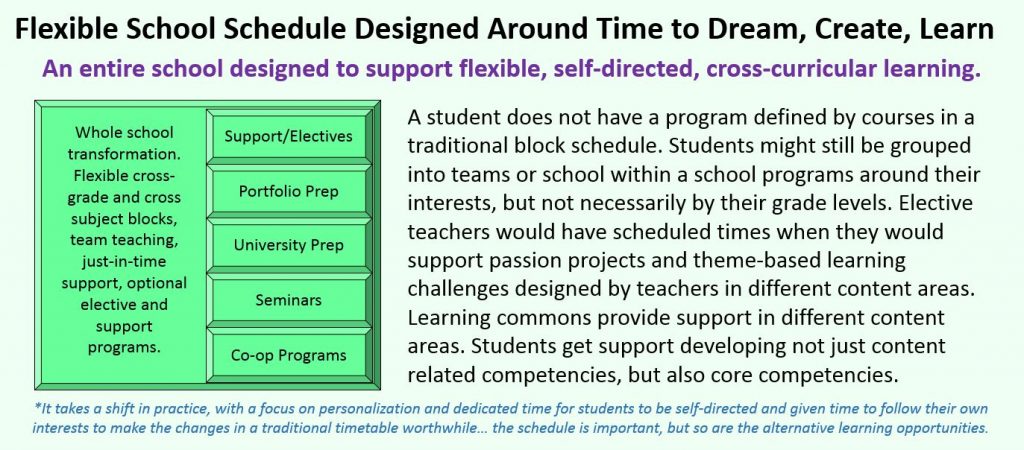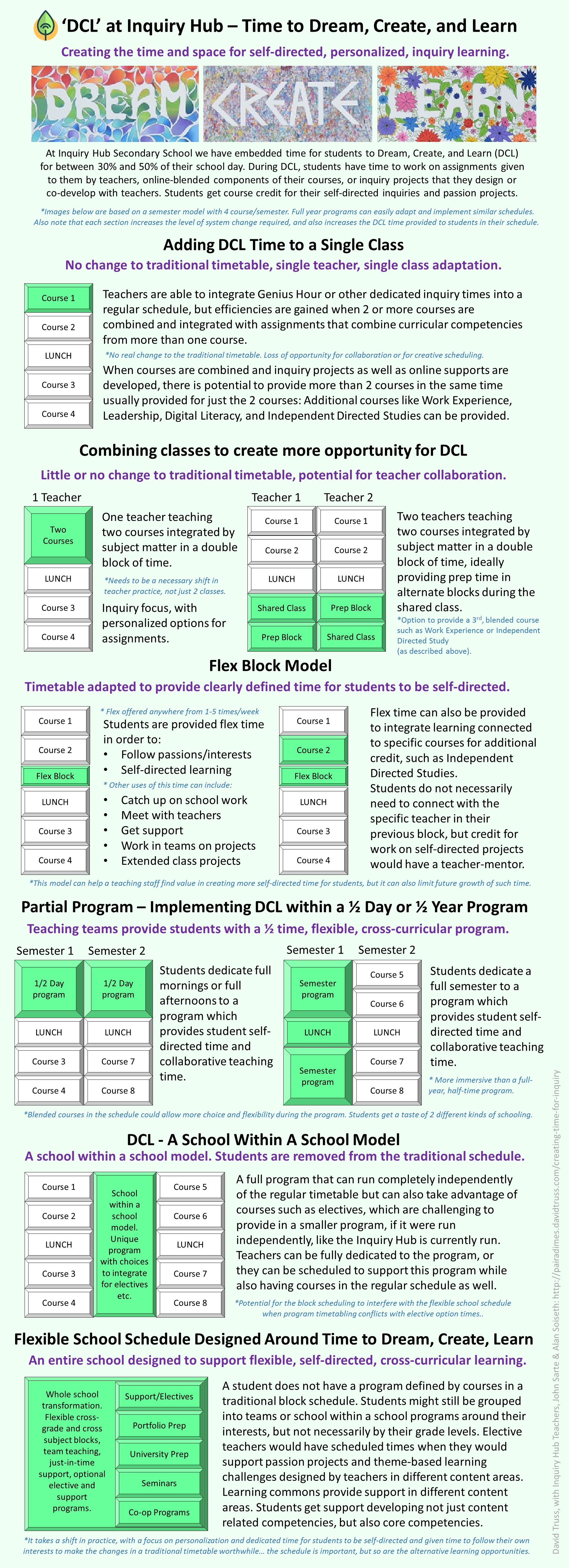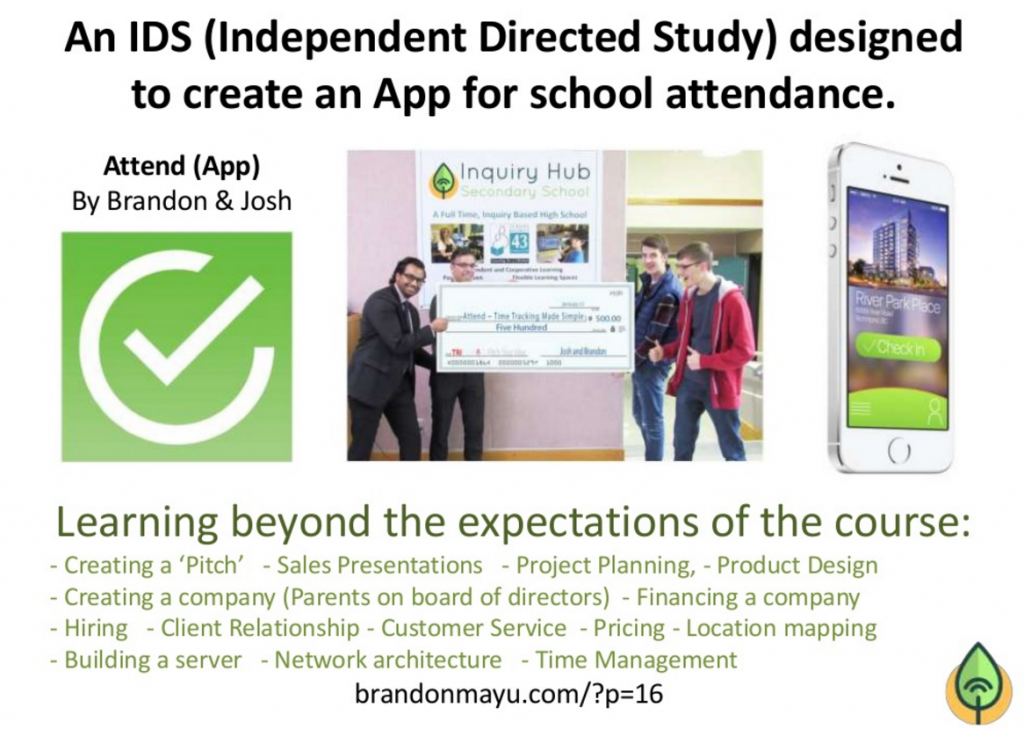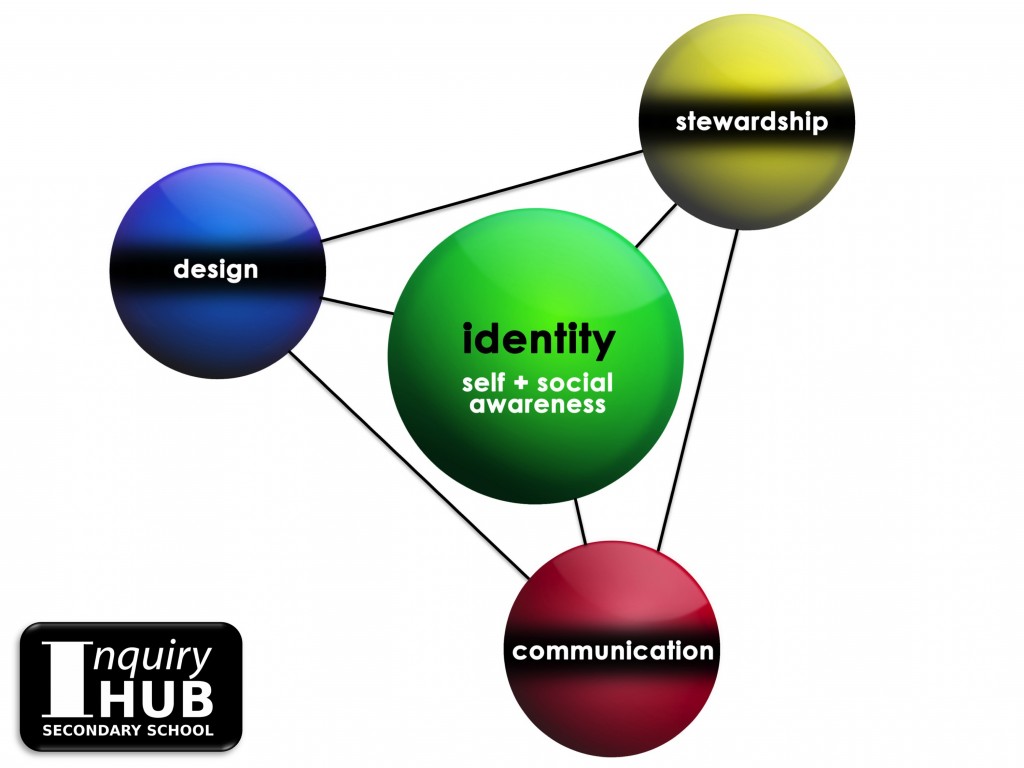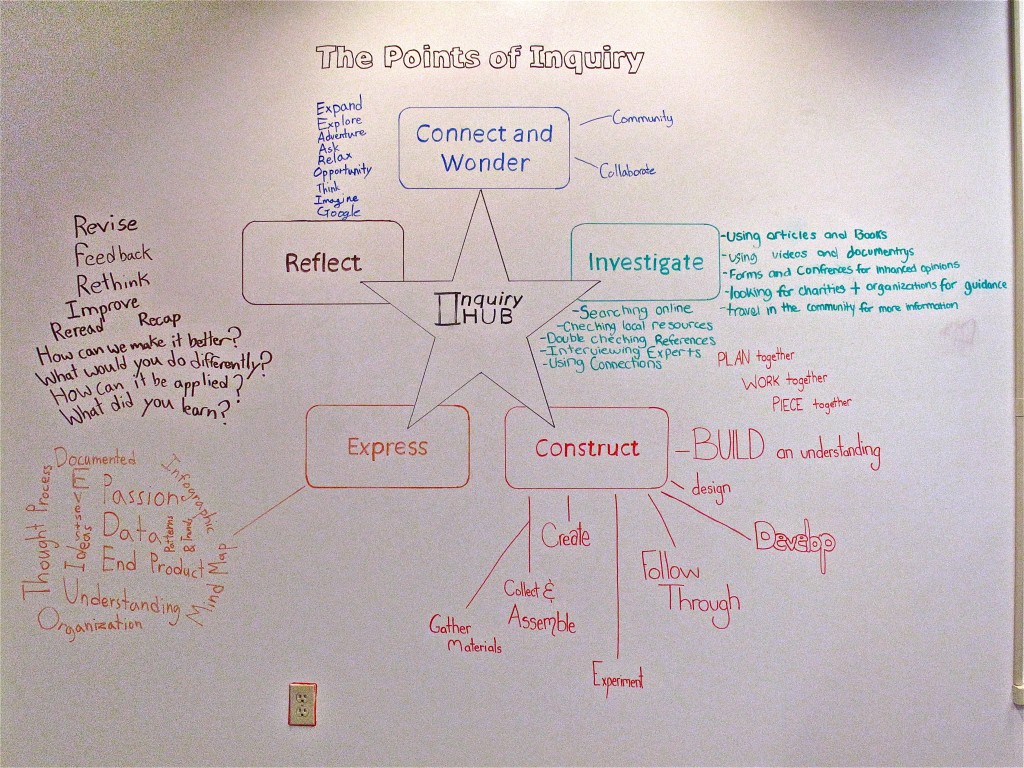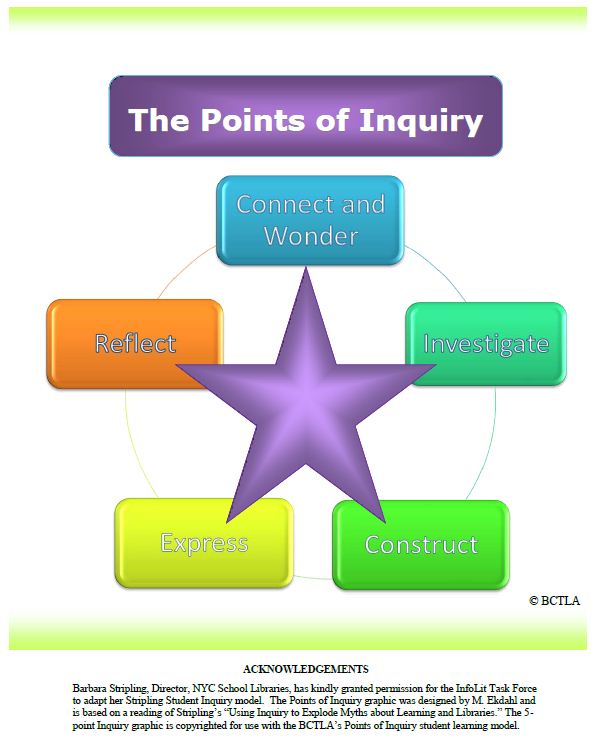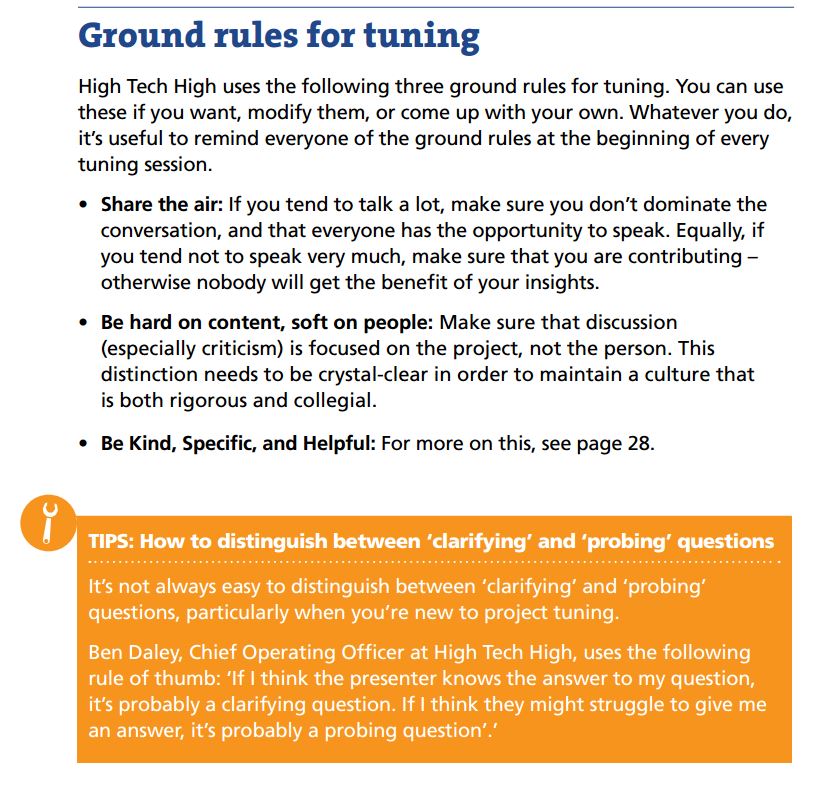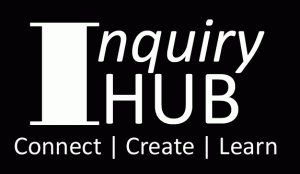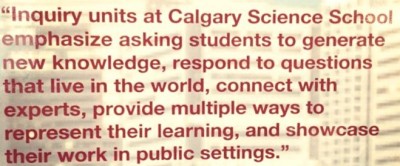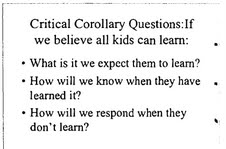Update: This application led to us becoming the award winner for the
Canadian Education Association’s
2014/2015 Ken Spencer Award for Innovation in Teaching and Learning.
Introduction
The Inquiry Hub (iHub) is a pilot program of choice for public school students in grades 9 to 12. It provides an innovative, technology-driven, full-time program which allows students to pursue their own learning questions by shaping their educational experience around their interests instead of structured classes. Currently in its third year of operation, iHub serves a student population of 53 through a blended learning environment – 45 of these students attend school five days per week from 9 am to 3 pm and many of their course requirements are mediated through Moodle – an online learning management system.
Our students are a mix of neighbourhood and cross-boundary kids who have chosen to come to our school. Their learning profiles include regular students whose families want a small school setting, as well as gifted students and students with specific learning challenges that include written output, attention and anxiety issues.
- The Inquiry Hub offers the following benefits to students:
- A student-driven inquiry approach to learning
- Blended instruction featuring both classroom and online experiences in a hybrid model
- Significant reduction of formally structured class time and emphasis on a learning commons where students work on group projects and individual, computer-mediated learning
- Extensive use of peer mentorship in cross-grade and cross-curricular project work
- Parents and community as active learning partners
- Core, inquiry-based program offerings extended through the expansive offerings of Coquitlam Open Learning (online) courses.
The Challenge
Imagine a student arrives at school and begins to work on a project primarily of her own design. Within a few minutes, she enters a state of flow (Csikszentmihalyi, 2000; 2004). Her sense of the passage of time disappears in the background and she is very absorbed in her work. The work becomes a reward in itself. For this student, schoolwork is a creative endeavour where failure occurs often, but is seen only as a necessary step toward enjoyment and fulfilment (Robinson, 2006). The challenge addressed through the Inquiry Hub program can be described as an attempt to cultivate student-engagement so that all of our students exercise their creativity and find flow in their work.
We design our program with the aim of harnessing students’ intrinsic motivation to learn by making their school time more meaningful and relevant. In contrast, a more traditional secondary school is already limited by bell schedules, the transfer of students between classes and teachers, and the accepted practice of keeping all learners at the same pace. Typically, much of a student’s day is devoted to learning others’ objectives rather than her own. The Inquiry Hub program is an attempt to focus the learning experience more on the student’s interests but meet prescribed learning outcomes at the same time.
Our work at the Inquiry Hub is not unique in its mission and follows the work of others, for example, Thomas Haney Secondary and High Tech High. Our design, however, is innovative in its three-pronged approach and its application within our local context (e.g., in a BC public school district, in conjunction with online learning, in a re-purposed elementary school, with grades 9 to 12 students who do not already have preparation for inquiry learning, etc.). The innovation consists of multiple changes implemented since the beginning of Inquiry Hub in 2012. Our re-creation of the secondary school may be summarized in three inter-connected changes:
1. Inquiry learning
2. Blended learning
3. Thematic learning
Inquiry learning involves students in the planning of the work that they do. It is immediately meaningful and already comes from personal interest and intrinsic motivation. With a blended learning environment, students are able to complete sections of the course online at a pace and location of their own choosing. For example, a student may study notes and practice problems for math at home and ask for help with challenging questions at school. More significantly, two of our students are learning to build and maintain 3D printers as an inquiry project but they depend on online resources to get help when it does not work as expected. In addition, thematic learning is used as a way of designing cross-curricular and cross-grade lessons that are meaningful for students and have the potential to introduce students to key ideas and new directions for inquiry (Fogarty, 1997). For example, a documentary on the decomposition of food led two students to cultivate and study the behaviour of slime mould. All three teachers collaborate to plan thematic learning units so there is overlap with learning outcomes in multiple subject areas.
Overcoming Challenges
In our initial design of an inquiry program, all grade 9 students work through a course on the Foundations of Inquiry (FOI) that introduces a process or cycle of investigation (see resources). FOI supports students as they study topics of their own choosing on a small scale, within set timeframes, and culminates in presentations that demonstrate skills across multiple subject areas. IDS courses run similarly to the smaller projects in grades 9 and 10, but require far more focus, deeper learning and commitment (100-120 hours). Then, in each subsequent year, students would be able to design an Independent Directed Studies course (IDS) with the assistance of a teacher or administrator. In our second year, it became clear that most students were not yet prepared to find an area of interest, develop one or more research questions, and maintain a program of study to complete an IDS without losing interest. In addition, inquiry projects and IDS were regularly pushed aside or forgotten as students felt like they should be working on course work (i.e., the work available online).
In order to overcome these challenges and emphasize inquiry as the central feature of the school, we created a learning pathway that begins with the initial Foundations of Inquiry in grade 9, continues with a second FOI in grade 10, provides an option to complete Science and Technology 11 as a science-oriented inquiry course, and continues to allow for IDS projects in grades 11 and 12. The second FOI course provides students with the experience to plan and work through processes such as design thinking, inquiry in the natural and social sciences, philosophical inquiry, and art inquiry. The capstone project requires students to set up their first IDS project that they may choose to complete in grade 11. In addition, inquiry projects may also be completed within courses. For example, a Science 9 student might develop a micro controller board, such as an Arduino Uno, into a lunar rover for an inquiry project.
Our focus is to support personalized education by providing time and resources for students to define and explore their own inquiry projects, such as: designing and maintaining a school garden, writing a novel, or coding a new app. In our first two years, we have seen students construct and experiment with a 3D printer and CNC mill, learn to code Arduino microcontrollers to make music or operate robots, cultivate slime mould to study its behaviour, and design an aquaculture apparatus. In addition, a variety of smaller-scale projects have had persistent positive effects on the culture and learning environment of the school. For example, students have also provided us with a fish aquarium and they organized a ski and snowboard fieldtrip, floor hockey games, Halloween and Christmas events, and a computer programming club.
We encourage students to pursue their interests and make learning visible through their ability to design new products, services and experiences. We promote stewardship with our students to take care our school, their community and the world. For example, our students volunteer within our school but also in the community. In our first year, as a school community we built our garden (an inquiry project organized by three grade 9 students). That same year and each subsequent year, several students have volunteered to remove invasive plant species from local parks.
Furthermore, in our first year we assumed that the majority of students choosing to attend Inquiry Hub already had several topics they wished to study. However, in reality not all students were sufficiently aware of their own passions and talents to uncover an area of interest that they might sustain for an extended period of time. Similarly, the students’ interests, especially in grades 9 and 10, were very limited in scope and excluded much of the world. Thematic learning was introduced in part to invite students to think about big ideas, encounter more topics for study, and think across traditional subject areas.
A recent theme focused on perspective and asked the question: How do we sense the world? The capstone project consisted of a photo, a short story, and a short film. Each creation was intended to deepen students’ understanding of perspective as they explored one of three binaries: love/hate, order/chaos, or life/death. These binaries were selected by the students from a larger set presented by the teachers. Through multiple iterations and progressive feedback from teachers and peers, students were able to generate some thought-provoking work both in what students perceived as failures and as successes.
Thematic planning of units also has the potential advantage of grouping students together across grades (vertical integration) as well as across the curriculum. This allows for students to collaborate and learn with and from each other. Moreover, thematic learning allows three teachers to teach and support a wide variety of courses for students. A real challenge is the proliferation of Inquiry Hub supported courses as the program grows. In the future, we will encourage students, especially in grades 11 and 12, to get together around common interests and plan their own thematic units with the assistance of the teachers.
The primary challenge with using blended learning is the creation and development of online components. We have some collaborative and preparation time to make improvements but we have had to efficiently utilize our face-to-face time with students to balance out limitations in the digital portions of the course. A more reliable online component of the course will also help us support more courses as necessary.
Evidence of Success
We are continually evaluating the effectiveness of the Inquiry Hub and making adjustments. However, given that this is only year 3, quantitative data on graduation rates and similar data are limited. Consequently, we focus our attention on anecdotal feedback from parents provided through PAC meetings and individual conversations. We also have regular curriculum meetings involving teachers and an administrator. We discuss what is and is not working and devise a course of action for the short and long-term.
Central to our success is the input from students. We often consult with students on proposed changes to the program. We provide explanations for our curriculum design and listen to their feedback. Most recently, we conducted focus group interviews with each grade level. Students were asked about the balance between student-directed and teacher-directed time, the value of thematically-planned lessons, and their experiences with the online components of their courses. They were also asked if they had any ideas on how to improve their learning experiences.
Students are largely responsible for creating the culture at Inquiry Hub. This is done through the clubs and groups they participate in, the field trips they plan and the inquiry projects they design with an outcome directly connected to improving the operation of the school and the quality of the student experience. Our students are very much involved in the development of the Inquiry Hub.
Plans for sustainability and scalability
Through student-led inquiry, blended and thematic learning, and our emphasis on cultivating student engagement, we believe Inquiry Hub is a potential learning partner for other schools. Furthermore, we believe that the program we are developing will work better for larger schools with more students, teachers and available resources.
The long-term plans for the Inquiry Hub include a K to 12 vision of personalized learning. The model itself will need to unfold over a number of years, but a good way to describe it would be a continuum of personalized learning opportunities. For example, a K-12 school could have a Montessori or Reggio Emilia philosophy for primary years, a thematic/project-based pedagogy for middle years (similar to the IB Middle Years program), and the Inquiry Hub model for secondary school. In this system, students would gain self-regulation skills in the early years, be provided with large, thematic but primarily teacher-driven inquiry in the middle years, and then be prepared for large, personalized and student-driven inquiry in the secondary years.
Currently there is discussion about creating a combined middle/high school in a new housing development in Coquitlam, BC. This would be an ideal place to expand the Inquiry Hub model into a larger program.
Conclusion
We have had interest in our program from around the world with educators coming to see us from Australia, England, the USA, Ontario, Alberta and across BC. Currently a school is being re-modelled to be inquiry-based in Abbotsford, BC and they are using our Digital Media and Foundations of Inquiry courses as cornerstones to the program.
Professor Stephen Heppell said with respect to new learning spaces:
“The world is actually filled with great ingredients for learning… reach out to other places, other colleagues, borrow their ingredients and make a great local recipe. Your school is filled with unique students, unique staff, and unique circumstances, in a unique context with a unique culture. Nothing out there will identically work for you. But the challenge is what is your local recipe going to be. All I’m saying is use the ingredients that are tested and tried in 21st Century Schools and build yourself a new local recipe. And then share it with others and then keep the menu fresh.”
With this quote in mind, we think that we are using relevant ingredients and creating a unique local recipe. Much of what we are doing is being shared and adapted to other local contexts and we are also open to learning from others.
At the Inquiry Hub, students are actively engaged in their learning. For example, they have opportunities to set their own pace using online course materials, participate in a novel study by selecting from a range of books, form clubs that can meet during Friday afternoons, organize field trips, and, of course, design inquiry projects. Students are encouraged to share their ideas, perspectives and new knowledge through social media and personal blogs. They are asked to think about real issues, such as over population or genetic modifications, and develop an informed opinion. Ultimately, the success of the Inquiry Hub depends on our ability to support students as they take on real projects that have relevance beyond school, for example, urban farming, designing a tiny home, or 3D printing. Where students are able to pursue their interests, we collectively learn and experience a shared state of flow.
If we are successful in our application, we would use the Ken Spencer award money to directly support student inquiries. For example, we might purchase VEX robotics kits for one group who would like to advance their understanding of computer programming through the development of robotics. Additionally, other students have an interest in inquiry focused on art or music, so funding might be used to acquire art supplies or even musical instruments.
Resources
Inquiry Learning
Alberta Ministry of Education: https://education.alberta.ca/teachers/aisi/themes/inquiry.aspx
Galileo.org Educational Network: http://galileo.org/teachers/designing-learning/articles/what-is-inquiry/
Ontario Ministry of Education: http://www.edu.gov.on.ca/eng/literacynumeracy/inspire/research/CBS_InquiryBased.pdf
Queens University:
http://www.queensu.ca/ctl/resources/topicspecific/inquirybased.html
Blended Learning
Edutopia: http://www.edutopia.org/khan-academy-discovery-lab-blended-learning-video
High Tech High: http://www.hightechhigh.org/about/design-principles.php
Ontario Ministry of Education: http://www.edu.gov.on.ca/elearning/blend.html
University of Waterloo:
https://uwaterloo.ca/centre-for-teaching-excellence/resources/blended-learning
References
Csikszentmihalyi, M. (2000). Beyond boredom and anxiety: Experiencing flow in work and play, 25th anniversary edition. San Francisco: Jossey-Bass.
Csikszentmihalyi, M. (2004, February). Mihaly Csikszentmihalyi: Flow, the secret to happiness [Video file]. Retrieved from http://www.ted.com/talks/mihaly_csikszentmihalyi_on_flow
Deci, E.L., Koestner, R., & Ryan, R.M. (2001). Extrinsic Rewards and Intrinsic Motivation in Education: Reconsidered Once Again. Review of Educational Research, 71(1), 1-27. Retrieved from http://www.jstor.org/stable/3516064
Deci, E.L., Vallerand, R.J., Pelletier, L.G., & Ryan, R.M. (1991). Motivation and education: the self-determination perspective. Educational Psychologist, 26 (3 & 4), 325-346.
Fogarty, R. (1997). Problem-based learning and other curriculum models for the multiple intelligences classroom. Arlington Heights, IL: IRI/SkyLight Training and Publishing.
Pink, D.H. (2009). Drive: the surprising truth about what motivates us. New York: Riverhead Books.
Robinson, K. (2006, February). Ken Robinson: How schools kill creativity [Video file]. Retrieved from http://www.ted.com/talks/ken_robinson_says_schools_kill_creativity


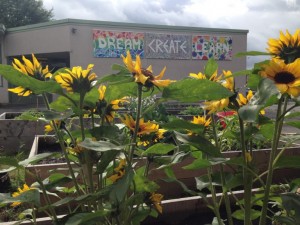 The story behind Our Community Garden ~ One of Inquiry Hub’s first inquiry projects.
The story behind Our Community Garden ~ One of Inquiry Hub’s first inquiry projects.
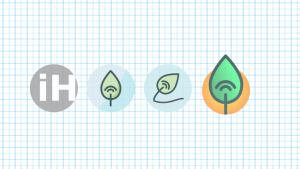 How Inquiry Hub’s Logo came to be.
How Inquiry Hub’s Logo came to be.